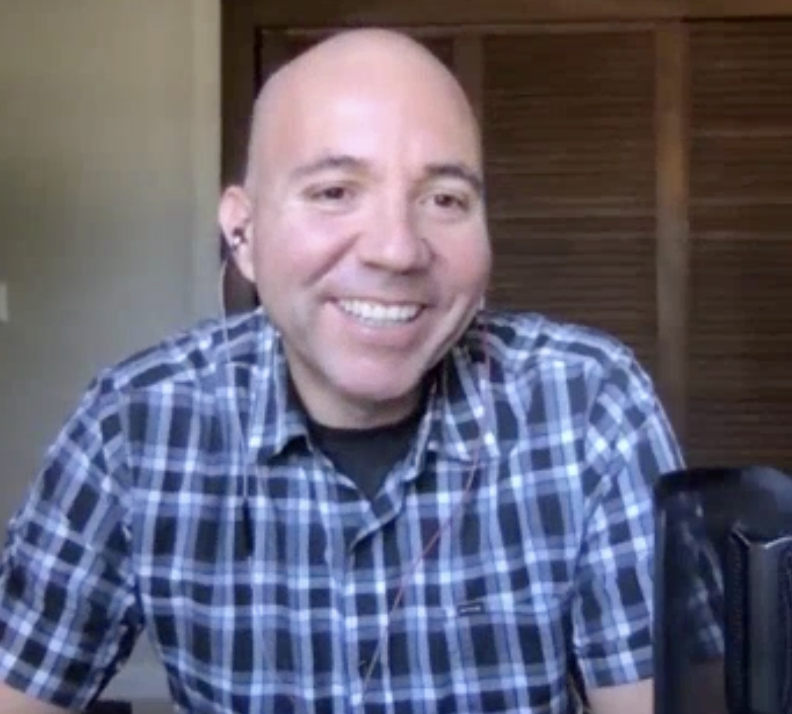
As a community manager, I’m always studying my company’s tweets to see what content drives more engagement than others. And this can help me decide on what type of content we need to be developing more of.
Researchers at the Palo Alto Research Center studied 74 million tweets through the Twitter API to discover common attributes of tweets that get retweeted.
They wanted to find out what elements in a tweet helped increase the retweet rate (e.g. URL, hashtag, mentions) and what about tweet authors drove more retweets (e.g. follower count, followee count, age of account, number of favorites by user, etc.).
Here is what they discovered:
Tweets with a URL are more likely to get retweeted.
When the researchers analyzed the 74M tweets, they discovered that 21.1% of tweets had at least one URL in their text. And when they analyzed retweets only, they found that 28.4% of those tweets had URLS. This data reveals URLs in tweets has a significant impact on retweetability.
This goes along with Dan Zarella’s retweet research who also reported that URLs in tweets increase the likelihood of getting retweeted.
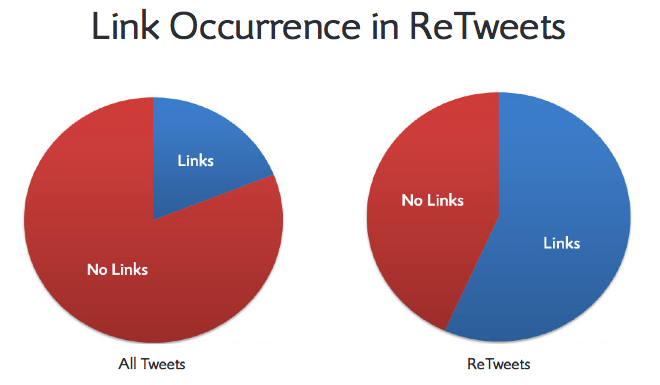
In Zarella’s research he found that 18.96% of tweets contained a link, whereas 56.69% of retweets included a link. Both studies show that tweets with links have a higher probability of getting retweeted.
Actionable Advice: Schedule half of your tweets in the next 30 days with links and half without. Review your metrics at the end of the 30 day period to see if tweets with links receive more retweets and/or favorites than those without links. I’m going to test this for myself and share my data here.
Type of URL in tweet impacts retweetability.
The researchers took time to study the types of URLs that were more likely to get retweeted. Since many people use URL shorteners (e.g. bit.ly, ow.ly), the researchers unshortened the URLs to find out what domains received the most retweets.
Here is the retweet data for the top 10 most popular domains in their data set:

As you can see, the destination URL has a significant impact on the retweet rate. In this data, a technology news websites like Mashable.com was far more likely to get reweeted than news from the BBC. This might because many people on Twitter enjoy social media news – so news and factoids from Mashable.com were more shareable than world news from the BBC.
The research also revealed that “personal media domains such as justin.tv and twitcam.com had a very low retweet rate (< 0.15) while trivia sites such as omg-facts.com and realtime discover engines such as holykaw.alltop.com have high retweet rate (> 4.0).”
This doesn’t mean you should start tweeting out Mashable.com news or content from omg-facts.com to your community. This merely shows you that the type of domain you share with your community matters. Some domains carry more credibility and/or interesting content than others. You want to tweet out news and info from sites your community cares about.
Dan Zarella did a similar study of 30 million retweets to find out the retweetability of URL shorteners. His research revealed that popular shortened URLs like bit.ly and ow.ly received more retweets than older and longer domains like tinyurl.com and twitpic.com.
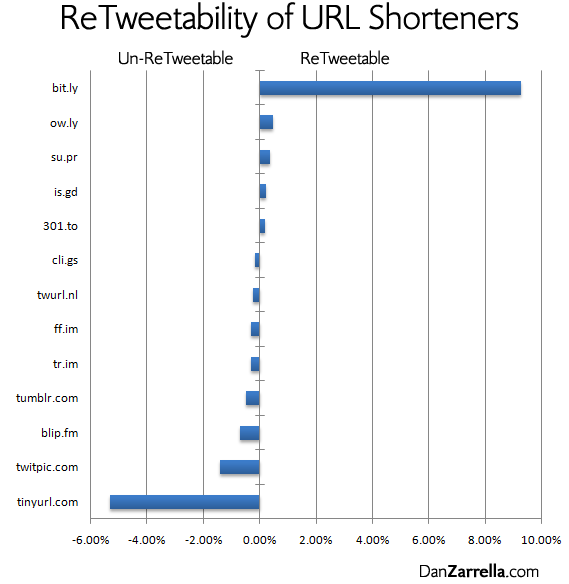
In another study, tweets with using pic.twitter.com were 94% more likely to be retweeted, while tweets with instagram links are 42% less likely to be retweeted.
Actionable Advice: Keep track of what websites your community shares on Twitter. Do you see any patterns? What type of news do they share? Any specific websites get shared more frequently than others? Keep these domains and topics in mind when composing future tweets.
Tweets with a hashtag are more likely to get retweeted.
The researchers found that only 10.1% of the 74M tweets contained a hashtag – and that 20.8% of retweets contained a hashtag. This reveals that adding hashtags in tweets can significantly impact your retweetability.
Here are the top 10 most popular hashtags impacting retweet rate in this study:
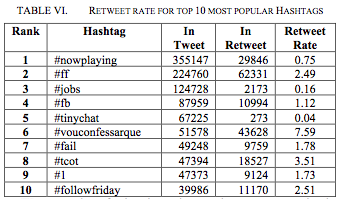
It’s interesting to see how #FollowFriday and its shorter equivalent #FF almost guarantees retweets (often because people want to share that other people are recommending them). If you’re not recommending others in a #FollowFriday tweet, this can be a simple way to get some attention and retweets. Just make sure you sincerely mean it.
The researchers also noticed that simply having a popular hashtag in a tweet didn’t impact retweetability. In the graph below, you’ll see on the X-axis the popularity rank of hashtags in Twitter based on how many times the hashtag appeared in the 74M data set. The Y-axis denotes the retweet rate.
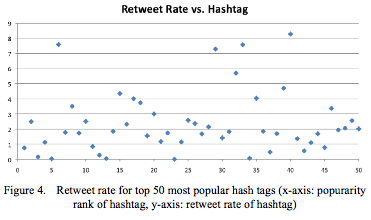
Notice that the volume of retweets is spread fairly evenly under 5 (no matter how popular the hashtag was). In this study, simply using a popular hashtag didn’t significantly impact retweets.
In another study of 1.2M tweets, Zarella found that tweets that contain one or more hashtags were 55% more likely to be retweeted than tweets that did not.
Actionable Advice: If you’re not using hashtags in tweets, make an effort to start using them. When relevant, test trending hashtags, funny hashtags, and relevant keyword hashtags.
Twitter users who have more followers (and follow others) receive more retweets.
As you can expect, the more followers you have – the more reach and retweets you’ll be able to get. In the chart below, you can see that the retweet rate rises as the follower count increases.
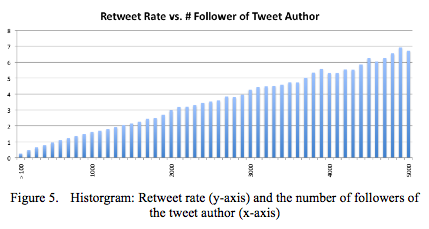
What’s also interesting is that there is a similar graph for retweet rate of Twitter users who follow more people. The researchers in this study suggest that those following more people have a more diverse stream of content to engage with – and might have more interesting tweets.
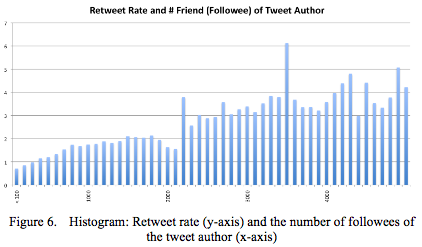
I think the reason retweets increase with “followee” count is simply because if you’re following more people, then you probably have a larger “follower” count. People following 10K people probably have more followers than someone just following 1K people.
Actionable Advice: Focus on growing your Twitter follower count to increase your retweet rate. Increasing your Twitter following takes time because it means engaging with others, answering questions, participating in tweetchats, and following more people in your community.
Twitter users who have earned trust and built relationships earn more retweets.
Now that we have a better understanding about the features to increase retweetability (i.e. using hashtags, links, pictures), it’s important to also consider why people retweet.
People may retweet for a number of reasons:
- Retweet to share something interesting
- Retweet to show agreement and support
- Retweet as an act of friendship
- Retweet to show that you’re listening
- Retweet to agree and add on to that thought
- Retweet to promote someone in a community that others might not know
- Retweet another to reciprocate (because someone else retweeted them)
- Retweet to archive a great tweet
- Retweet something funny or entertaining
There are other reasons why people retweet, but many of these reasons are based on trust. People need to trust the information you’re tweeting in order to earn retweets.
This is one reason why people with older Twitter accounts tend to have more retweets. It’s not just because older accounts have more followers, it’s because they’ve earned trust and more relationships over time.
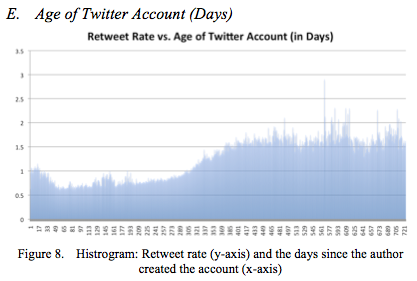
The more time you spend with your community, the more likely they’ll get to know and trust you (which will earn you more retweets in the future).
Getting retweeted also depends on what you say and who is reading it at the time. If you’re in a tweetchat with a bunch of people, you’re more likely to get retweeted because you’re engaged with a group of people on a similar topic.
So what types of tweets have earned you more retweets? Would love to dialogue with you in comments.

